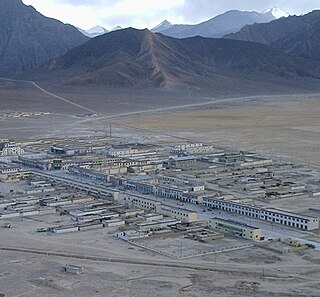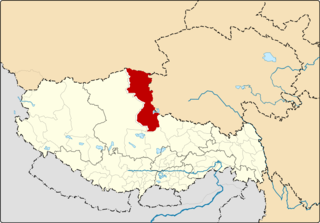
Rutog County is a county in Ngari Prefecture, Tibet Autonomous Region of the People's Republic of China. The county seat is Rutog, located some 1,140 km (710 mi) or 700 miles west- northwest of the Tibetan capital, Lhasa. Rutog County shares a border with India.

Shuanghu County, also transliterated from Tibetan as Co Nyi County, is a county under the jurisdiction of the prefecture-level city of Nagqu, in the northernmost part of the Tibet Autonomous Region, People's Republic of China. It was formed in 2012, combining the territory of the former Shuanghu Special District with the eastern half of Nyima County. Much of the county is within the Changtang area.

Qira County, alternatively Chira or Cele, is a county in Hotan Prefecture, Xinjiang Uyghur Autonomous Region, China. Almost all the residents of the county are Uyghurs and live around oases situated between the desolate Taklamakan Desert and Kunlun Mountains. The county is bordered to the north by Aksu Prefecture, to the east by Yutian / Keriya County, to the northwest by Lop County, to the southwest by Hotan County including the China-India disputed Aksai Chin area and to the south by Rutog County, Ngari Prefecture in Tibet.
Barma, or Pama, Pamaxiang, also spelled Parma or Jarma) is a small town and township-level division in Zhongba County in the Shigatse Prefecture of the Tibet Autonomous Region of China. It is located roughly 500 kilometres (310 mi) northwest of Lhasa next to Chabyer Co lake, north of Taro Co. The township was established in 1961 and covers an area of 4,098 square kilometres (1,582 sq mi).
Gangnyi, Gangni, Gangnyixiang or Gangnixiang is a village and township-level division of Amdo County in the Nagqu Prefecture of the Tibet Autonomous Region, in China. It is located roughly 60 kilometres (37 mi) northwest of Amdo Town. The township covers an area of 5,019 kilometres (3,119 mi) and as of 2004 it had a population of around 1,300. The principal economic activity is animal husbandry, pastoral yak, goat, sheep, and so on.
Sewu, Sêwa or Sewuxiang is a village and township-level division of Amdo County in the Nagqu Prefecture of the Tibet Autonomous Region, in China. It lies near Qixiang Lake. The township covers an area of 5,647 kilometres (3,509 mi) and in 2004 it had a population of about 1,000. The principal economic activity is animal husbandry, pastoral yak, goat, sheep, and so on.
Jiaqiong or Jakhyung Town, also known as Jongnag is a small town and township-level division in Baingoin County, Nagqu in the Tibet Autonomous Region of the People's Republic of China. It covers an area of 2,993 square kilometres (1,156 sq mi) and as of 2010 it had a population of 2926 people. Jiaqiong lies to the northwest of Beila, to the east of Amdo County, and south of Shuanghu County.
Lhari is a small town and seat of Lhari County in the Nagqu Prefecture of the Tibet Autonomous Region, in China. It is located northeast of Lhasa, southeast of Nagchu Town, southwest of Banbar Town and north of Gongbo'gyamda. In 2004 it had a population of about 1,000.
Lingti, also Lindi or Lindixiang is a small town and township-level division of Lhari County in the Nagqu Prefecture of the Tibet Autonomous Region, in China. It lies along the S305 road, 105 kilometres (65 mi) northwest of Lhari Town and 100 kilometres (62 mi) southwest by road of Nagchu Town. As of 2004 it had a population of about 1100. The principal economic activity is animal husbandry, pastoral yak, goat, sheep, and so on. The town's name means "forest embankment".
Xarma, also Sharma, Xiama or Xiamaxiang is a small town and township-level division of Lhari County in the Nagqu Prefecture of the Tibet Autonomous Region, in China. It lies along the S305 road, 69.4 kilometres (43.1 mi) northwest of Lhari Town and 136 kilometres (85 mi) southwest by road of Nagchu Town. As of 2004 it had a population of about 1700. The principal economic activity is animal husbandry, pastoral yak, goat, sheep, and so on.
Zharen, also Zaring or Zharencun is a small town and township-level division of Amdo County in the Nagqu Prefecture of the Tibet Autonomous Region, in China. It is located at the side of the G109 road, 41.9 kilometres (26.0 mi) south of Amdo Town on the road from Nagchu Town, and approximately 20 kilometres (12 mi) east of the southern tip of Cona Lake. It has a population of 7875, living in 1479 households.
Namling or Namlingxoi is a town and seat of Namling County in the Tibet Autonomous Region of China, about 72 kilometres (45 mi) by road northeast of Shigatse, north of Dobjoi.
Xainza is a town and township-level administrative unit and seat of Shentsa County or Xainza County, Nagqu Prefecture, Tibet Autonomous Region, China.
Codoi is a small town and township in Lhari County in Nagqu Prefecture of the Tibet Autonomous Region, in China. It had a population of about 16,000 as of 2004.
Cuoma, or Cuomaxiang is a village and township-level division of Amdo County in the Nagqu Prefecture of the Tibet Autonomous Region, in China. It is located roughly 30 kilometres (19 mi) southwest of Amdo Town near the northern bank of Cona Lake. It covers an area of 5,098 square kilometres (1,968 sq mi) and as of 2004 had a population of about 3,100. Cuoma township of Amdo County has existed since 1960 and was further expanded in 1987, but Cuoma has also been listed under the jurisdiction of Seqing Township of Nyainrong County. The principal economic activity is animal husbandry, pastoral yak, goat, sheep, and so on.
Qiangma, also Qangma or Qiangmazhen is a small town and township-level division of Amdo County in the Nagqu Prefecture of the Tibet Autonomous Region, in China. It is located just south of Zi Getangcuo Lake, 90.7 kilometres (56.4 mi) southwest of Amdo Town. It covers an area of 5,467 square kilometres (2,111 sq mi) and as of 2004 it had a population of about 1700. The principal economic activity is animal husbandry, pastoral yak, goat, sheep, and so on.
Yanshiping is a small town physically situated in the southwest of Qinghai province, China. However, it is under the jurisdiction of Amdo County in the Nagqu Prefecture of the Tibet Autonomous Region. At an elevation of 4,720 metres (15,490 ft), it is one of the highest year-round settlements in the world.
Domar was a mythological king of Sweden.
Tingping Township is a rural township in Chengbu Miao Autonomous County, Hunan, China. As of the 2015 census it had a population of 17,200 and an area of 255.76-square-kilometre (98.75 sq mi). The town shares a border with Wutuan Town to the west, Baimaoping Township to the east, Rulin Town to the north, and Jiangdi Township of Longsheng Various Nationalities Autonomous County to the south.
Lianshan is a town in Fuchuan Yao Autonomous County, Guangxi, China. As of the 2018 census it had a population of 27,000 and an area of 107.5-square-kilometre (41.5 sq mi).




